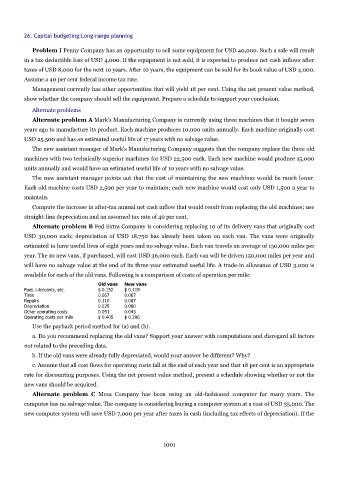Page 1000 - Accounting Principles (A Business Perspective)
P. 1000
26. Capital budgeting:Long-range planning
Problem I Penny Company has an opportunity to sell some equipment for USD 40,000. Such a sale will result
in a tax-deductible loss of USD 4,000. If the equipment is not sold, it is expected to produce net cash inflows after
taxes of USD 8,000 for the next 10 years. After 10 years, the equipment can be sold for its book value of USD 4,000.
Assume a 40 per cent federal income tax rate.
Management currently has other opportunities that will yield 18 per cent. Using the net present value method,
show whether the company should sell the equipment. Prepare a schedule to support your conclusion.
Alternate problems
Alternate problem A Mark's Manufacturing Company is currently using three machines that it bought seven
years ago to manufacture its product. Each machine produces 10,000 units annually. Each machine originally cost
USD 25,500 and has an estimated useful life of 17 years with no salvage value.
The new assistant manager of Mark's Manufacturing Company suggests that the company replace the three old
machines with two technically superior machines for USD 22,500 each. Each new machine would produce 15,000
units annually and would have an estimated useful life of 10 years with no salvage value.
The new assistant manager points out that the cost of maintaining the new machines would be much lower.
Each old machine costs USD 2,500 per year to maintain; each new machine would cost only USD 1,500 a year to
maintain.
Compute the increase in after-tax annual net cash inflow that would result from replacing the old machines; use
straight-line depreciation and an assumed tax rate of 40 per cent.
Alternate problem B Fed Extra Company is considering replacing 10 of its delivery vans that originally cost
USD 30,000 each; depreciation of USD 18,750 has already been taken on each van. The vans were originally
estimated to have useful lives of eight years and no salvage value. Each van travels an average of 150,000 miles per
year. The 10 new vans, if purchased, will cost USD 36,000 each. Each van will be driven 150,000 miles per year and
will have no salvage value at the end of its three-year estimated useful life. A trade-in allowance of USD 3,000 is
available for each of the old vans. Following is a comparison of costs of operation per mile:
Old vans New vans
Fuel, lubricants, etc. $ 0.152 $ 0.119
Tires 0.067 0.067
Repairs 0.110 0.087
Depreciation 0.025 0.080
Other operating costs 0.051 0.043
Operating costs per mile $ 0.405 $ 0.396
Use the payback period method for (a) and (b).
a. Do you recommend replacing the old vans? Support your answer with computations and disregard all factors
not related to the preceding data.
b. If the old vans were already fully depreciated, would your answer be different? Why?
c. Assume that all cost flows for operating costs fall at the end of each year and that 18 per cent is an appropriate
rate for discounting purposes. Using the net present value method, present a schedule showing whether or not the
new vans should be acquired.
Alternate problem C Mesa Company has been using an old-fashioned computer for many years. The
computer has no salvage value. The company is considering buying a computer system at a cost of USD 35,000. The
new computer system will save USD 7,000 per year after taxes in cash (including tax effects of depreciation). If the
1001

